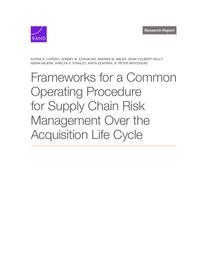Frameworks for a Common Operating Procedure for Supply Chain Risk Management Over the Acquisition Life Cycle
ResearchPublished Dec 5, 2024
There is no formal procedure on how to manage the array of risks that can afflict U.S. Army supply chains. As a result, the Army has a limited ability to proactively identify and manage supply chain risk across a weapon system program's life cycle. In this report, the authors develop frameworks to support implementation of an Army common operating procedure for identifying and managing supply chain risks during the weapon system's life cycle.
ResearchPublished Dec 5, 2024

Although policy guidance is in place to manage some risks, there is no comprehensive procedure on how to manage the array of risks that can afflict U.S. Army supply chains. Because the Army lacks a comprehensive supply chain risk management (SCRM) system, there is limited ability to proactively identify and manage supply chain risks across a weapon system program's life cycle. In this report, the authors develop frameworks to support implementation of an Army common operating procedure for identifying and managing supply chain risks during the acquisition life cycle.
The authors surveyed the SCRM literature to catalog and define 10 supply chain risk categories and 31 supply chain risk drivers. They also documented lessons learned from three supply chain risk case studies. The authors reviewed the process steps and documents reflected in the Army acquisition life cycle; interviewed representatives from the acquisition and sustainment communities to understand the existing approach to SCRM; and then identified the steps along the process where supply chain risk activities might take place.
The authors recommend the adoption of three interconnected SCRM frameworks that span the weapon system's life cycle. By managing across three frameworks, the Army can focus SCRM activities within the organizations that have the most knowledge and information about the weapon system at that point in the life cycle. The interrelated nature of the frameworks promotes sharing knowledge and acknowledging the changing nature of risks across the life cycle.
This research was prepared for the United States Army and conducted within the Forces and Logistics Program of RAND Arroyo Center.
This publication is part of the RAND research report series. Research reports present research findings and objective analysis that address the challenges facing the public and private sectors. All RAND research reports undergo rigorous peer review to ensure high standards for research quality and objectivity.
This document and trademark(s) contained herein are protected by law. This representation of RAND intellectual property is provided for noncommercial use only. Unauthorized posting of this publication online is prohibited; linking directly to this product page is encouraged. Permission is required from RAND to reproduce, or reuse in another form, any of its research documents for commercial purposes. For information on reprint and reuse permissions, please visit www.rand.org/pubs/permissions.
RAND is a nonprofit institution that helps improve policy and decisionmaking through research and analysis. RAND's publications do not necessarily reflect the opinions of its research clients and sponsors.